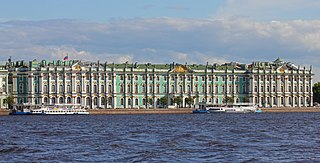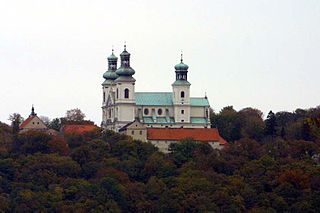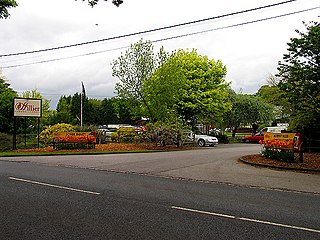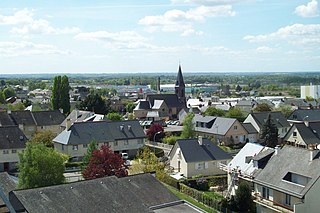
The State Hermitage Museum is a museum of art and culture in Saint Petersburg, Russia. The second-largest art museum in the world, it was founded in 1764 when Empress Catherine the Great acquired an impressive collection of paintings from the Berlin merchant Johann Ernst Gotzkowsky. The museum celebrates the anniversary of its founding each year on 7 December, Saint Catherine's Day. It has been open to the public since 1852.

The Hermitage is a historical plantation and museum located in Davidson County, Tennessee, United States, 10 miles (16 km) east of downtown Nashville. The plantation was owned by Andrew Jackson, the seventh President of the United States, from 1804 until his death at the Hermitage in 1845. Jackson only lived at the property occasionally until he retired from public life in 1837. Enslaved men, women, and children, numbering nine at the plantation's purchase in 1804 and 110 at Jackson's death, worked at the Hermitage and were principally involved in growing cotton, its major cash crop. It is a National Historic Landmark.
Hermitage or The Hermitage may refer to:

The Camaldolese monks and nuns are two different, but related, monastic communities that trace their lineage to the monastic movement begun by Saint Romuald.

Hermitage is a village and civil parish, near to Newbury, in the English county of Berkshire. The civil parish is made up of a number of settlements: Hermitage village, Little Hungerford and Wellhouse.

USS Hermitage (LSD-34) was a Thomaston-class dock landing ship of the United States Navy. She was named for The Hermitage, President Andrew Jackson's estate just outside Nashville, Tennessee.
Hermitage, Tennessee, is a neighborhood in Metropolitan Nashville, Tennessee, located in eastern Davidson County, adjacent to – and named in honor of – The Hermitage, the historic home of Andrew Jackson, seventh President of the United States. Although the area is incorporated as part of the Metropolitan Government of Nashville and Davidson County, it maintains its own identity as a residential and commercial suburban area.

Although today's meaning is usually a place where a hermit lives in seclusion from the world, hermitage was more commonly used to mean a building or settlement where a person or a group of people lived religiously, in seclusion. When included in the name of continental European properties or churches, any meaning is often imprecise, and may refer to some distant period of the history of what is today a property that is either a normal parish church, or ceased to have any religious function some time ago. Secondary churches or establishments run from a monastery were often called "hermitages".

Tain-l'Hermitage is a commune in the Drôme department in southeastern France.

L'Hermitage is a commune in the Ille-et-Vilaine department in Brittany in northwestern France.

Viguera is a municipality in La Rioja, Spain. It includes the villages Castañares de las Cuevas, El Puente, and Panzares.

The Winter Palace was the official residence of the Russian Emperors from 1732 to 1917. Today, the palace and its precincts form the Hermitage Museum. Situated between Palace Embankment and Palace Square, in Saint Petersburg, adjacent to the site of Peter the Great's original Winter Palace, the present and fourth Winter Palace was built and altered almost continuously between the late 1730s and 1837, when it was severely damaged by fire and immediately rebuilt. The storming of the palace in 1917, as depicted in Soviet paintings and Sergei Eisenstein's 1927 film October, became an iconic symbol of the Russian Revolution.
Hermitage Plaza is a project consisting of a podium and 6 buildings, including two towers, proposed by Hermitage Group for the Paris-La Défense business district. Upon completion in 2024, the two 323 metres (1,060 ft) tall towers with 86 and 85 floors will be the tallest buildings in the European Union.
Hermitage is a former settlement in Mendocino County, California. It was located 6 miles (9.7 km) east-southeast of original site of Yorkville.
The West Branch Pleasant River is a 36.1-mile-long (58.1 km) tributary of the Piscataquis River in Piscataquis County, Maine. From a location north of Fourth West Branch Pond in Shawtown, the river runs about 18 miles (29 km) counterclockwise around the White Cap Mountain massif, then about 18 miles (29 km) southeast to its confluence with the East Branch of the Pleasant River in Brownville.

Pabonka Hermitage, also written Pawangka, is a historical hermitage, today belonging to Sera Monastery, about 8 kilometres northwest of Lhasa in the Nyang bran Valley on the slopes of Mount Parasol in Tibet.

Keutsang Hermitage is a historical hermitage, belonging to the Sera Monastery, about 8 kilometres (26,000 ft) northwest of Lhasa in Tibet Autonomous Region. The hermitage was in a precariously perched cave once inhabited by the great Tibetan guru Tsongkhapa. However, the original cave collapsed in a landslide. What is present now was rebuilt, adjoining the ruined Keutsang West Hermitage, at a safer location. As it exists now, Keutsang is to the east of Sera on a hillside above Lhasa’s principal cemetery. Rakhadrak Hermitage is above and close to this hermitage.

Rakhadrak Hermitage is a historical hermitage belonging to the Sera Monastery. It is northeast of Sera and north of Lhasa in Tibet Autonomous Region. It is just up the mountain from the Keutsang Hermitage.

Hermitage is a residential area in the northeast portion of the City of Edmonton in Alberta, Canada. It was established in 1970 through Edmonton City Council's adoption of the Hermitage General Outline Plan, which guides the overall development of the area.



















